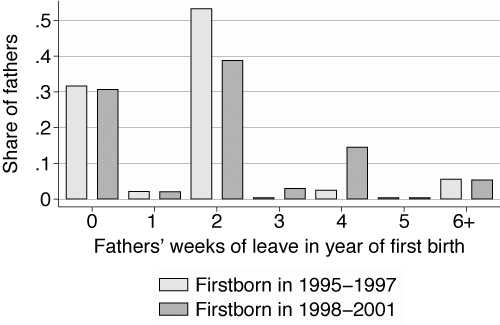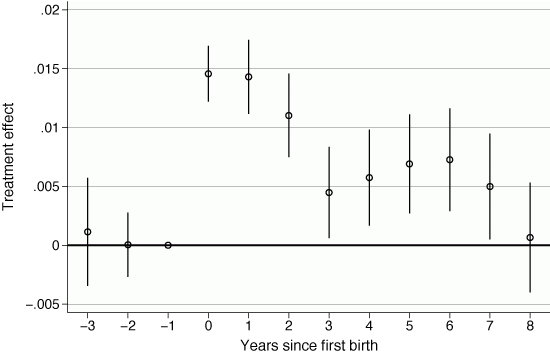The stark difference in average earnings between men and women in many western countries hovers around 15%, drawing the attention of politicians and scholars for whom gender inequality is a central issue. Some countries have already implemented policies to reduce gender inequality in the labour market. Recent research suggests that non-transferable parental leave reforms show promise in the fight to reduce gender inequality.
One of the most important drivers of gender inequality in the labour market is the arrival of children. A recent study estimates that around 80% of the difference between the average labour-market income of men and women in Denmark relates to the presence of children (Kleven et al. forthcoming). The average labour market income of women is significantly and permanently reduced after childbirth, while the same is not the case for men. This is an emerging stylised fact in many western countries, including the US and the UK (Kleven et al. forthcoming).
Recently, the European Parliament proposed imposing on member countries the requirement that each parent have the right to two months of non-transferable or ‘earmarked’ paid parental leave. One of the main arguments for earmarked parental leave legislation is that it will decrease gender inequality in the labour market by increasing the incentives for fathers to take more parental leave.
Earmarked paternity leave
Earmarking a portion of paternity leave for fathers increases the amount of leave taken by men. Research based on data from the US, Norway, Sweden, and Canada shows that earmarked paternity leave tends to increase significantly the parental leave taken by fathers (Farré et al. 2019). The question remains whether increasing the paternity leave taken by men has any other consequences for the children and their parents.
Recent research has documented an increase in women’s labour market participation and earnings as a direct consequence of earmarked paternity leave reforms. Earmarked parental leave for fathers increased the labour supply of mothers (Dunatchik et al. 2019), increased women’s earnings from earmarked paternity leave (Johansson 2010, Andersen 2018), and had large, long-lasting effects on gender roles as well as a significant increase in the time spent by women doing paid work in the labour market (Patnaik, forthcoming).
More mixed are the conclusions from research on the consequences for family formation and dissolution. Marital stability has been found significantly reduced as a result of earmarked paternity leave in Sweden (Avdic and Karimi 2018) while no effect has been found in Norway (Dahl et al. 2014) (Cools et al. 2015). One study found that earmarked paternity leave reduced fertility rates (Farré and González 2019); but a positive association between parental leave take-up and fertility has also been documented (Duvander et al. 2010).
In new research, we analyse the effect of earmarked parental leave for fathers on the relative income of women within couples (Druedahl et al. 2019). This is particularly interesting because women’s intra-household share of income likely reflects their bargaining power within the household. In turn, if policy reforms that include earmarked paternity leave shift the income share within households, such reforms have the potential to create permanent shifts in norms, in time allocation within the household, and thus to gender inequality more broadly.
Earmarked paternity leave and relative income within households
We use Danish register data together with a 1998 reform to the parental leave scheme. The reform increased the earmarked paternity leave for fathers to two weeks without changing the parental leave available to mothers. Fathers of children born before 15 October 1997 had two weeks of earmarked paternity leave (often used immediately after childbirth). Fathers of children born on or after 15 October 1997 had a total of four weeks of earmarked paternity leave.
Figure 1
First, we confirm the findings of the existing literature that earmarked paternity leave increases the amount of leave taken by fathers. Figure 1 illustrates the distribution of the number of weeks taken by first-time fathers who had their firstborn child before the reform (in the years 1995-1997), compared to first-time fathers who had their firstborn after the reform (in the years 1998-2001). We see a substantial shift from the share of first-time fathers taking two weeks of leave to fathers taking four weeks of leave. This response looks particularly large when we take into account the fact that fathers wanting to use this option had to take their leave in weeks 25 and 26 after childbirth. Likewise, we also find evidence of a child penalty for mothers, whose share of income decreases from 42% of household income before birth to around 32% one year after giving birth.
Second, we use this reform to estimate the impact on women’s labour income share within the household stemming from two weeks of increased earmarked paternity leave. We find a significant positive effect, suggesting that mothers’ share of labour income increased around 1.2 percentage points after the reform.
The increase in women’s labour income share arises because women’s labour income increases significantly while men’s labour income is scarcely affected. The effect on women’s labour income is relatively long lasting and remains significantly positive until the firstborn child reaches eight years, as illustrated in Figure 2. This suggests that there might be scope for shifting gender norms through earmarked parental leave reforms like the one proposed by the European Parliament.
Figure 2
We find that the effect is primarily driven by couples in which the woman was employed in the private sector prior to the first child’s birth. Fathers in this group increased their parental leave take-up by approximately twice as much as fathers in the reference group in which mothers worked in the public sector prior to childbirth. This result is in line with the notion that no long-run effects from taking parental leave exist for women employed in the public sector prior to childbirth (Nielsen et al. 2004).
Our results suggest that even a relatively small increase in earmarked parental leave for fathers can affect the parental leave take-up and subsequent impact on the distribution of labour market income within households. The persistence of the effect indicates that such reforms could shift gender norms and create more permanent consequences. Other research has suggested that norms are hard to change and that the effects of earmarked paternity leave are short-run (Ekberg et al. 2013). An interesting avenue for future research would be to investigate the long-term impact of earmarked parental leave.
The implementation of the European Parliament’s proposal of two months earmarked parental leave would lead to a substantial increase in earmarked leave for fathers in many EU countries and enable future research on the impact of earmarked parental leave outside a Scandinavian welfare model.
References
Andersen, S H (2018), "Parental Leave and the Motherhood Penalty: New Causal Evidence", Journal of Marriage and Family 80(5): 1125-1143.
Avdic, D and A Karimi (2018) "Modern Family? Paternity Leave and Marital Stability", American Economic Journal: Applied Economics 10 (4): 283-307.
Cools, S, J H Fiva, and L J Kirkebøen (2015) "Causal Effects of Paternity Leave on Children and Parents", Scandinavian Journal of Economics 117 (3): 801-828.
Dahl, G B, K V Løken, and M Mogstad (2014) "Peer Effects in Program Participation", American Economic Review 104 (7): 2049-2074.
Druedahl, J, M Ejrnæs, and T H Jørgensen (2019) "Earmarked Paternity LEave and the Relative Income within Couples", Economics Letters 180: 85-88.
Dunatchik, A and B Ozcan (2019) Reducing Mommy Penalties with Daddy Quotas, Working paper, London: LSE working paper.
Duvander, A-Z, T Lappegård, and G. Andersson (2010) "Family policy and fertility: fathers’ and mothers’ use of parental leave and continued childbearing in Norway", Journal of European Social Policy 20 (1): 45-57.
Ekberg, J, R Eriksson, and G Friebel (2013) "Parental leave - A policy evaluation of the Swedish 'Daddy-Month' reform", Journal of Public Economics 97: 131-143.
Farré, L, and L González (2019) "Does Paternity Leave Reduce Fertility?", Journal of Public Economics 172: 52-66.
Johansson, E-A (2010) The effect of own and spousal parental leave on earnings. Working Paper, Institute for Labour Market Policy Evaluation (IFAU).
Kleven, H, C Landais, and J E Søgaard (forthcoming) "Children and Gender Inequality: Evidence from Denmark", American Economic Journal: Applied Economics.
Kleven, H, C Landais, J Posch, A Steinhauer, and J Zweimuller (forthcoming) "Child Penalties Across Countries: Evidence and Explanations", AEA Papers & Proceedings.
Nielsen, H S, M Simonsen, and M Verner (2004) "Does the Gap in Family Friendly Policies Drive the Family Gap?", Scandinavian Journal of Economics 106 (4): 721-744.
Patnaik, A (forthcoming) "Reserving time for daddy: The consequences of fathers' quotas." Journal of Labor Economics.









